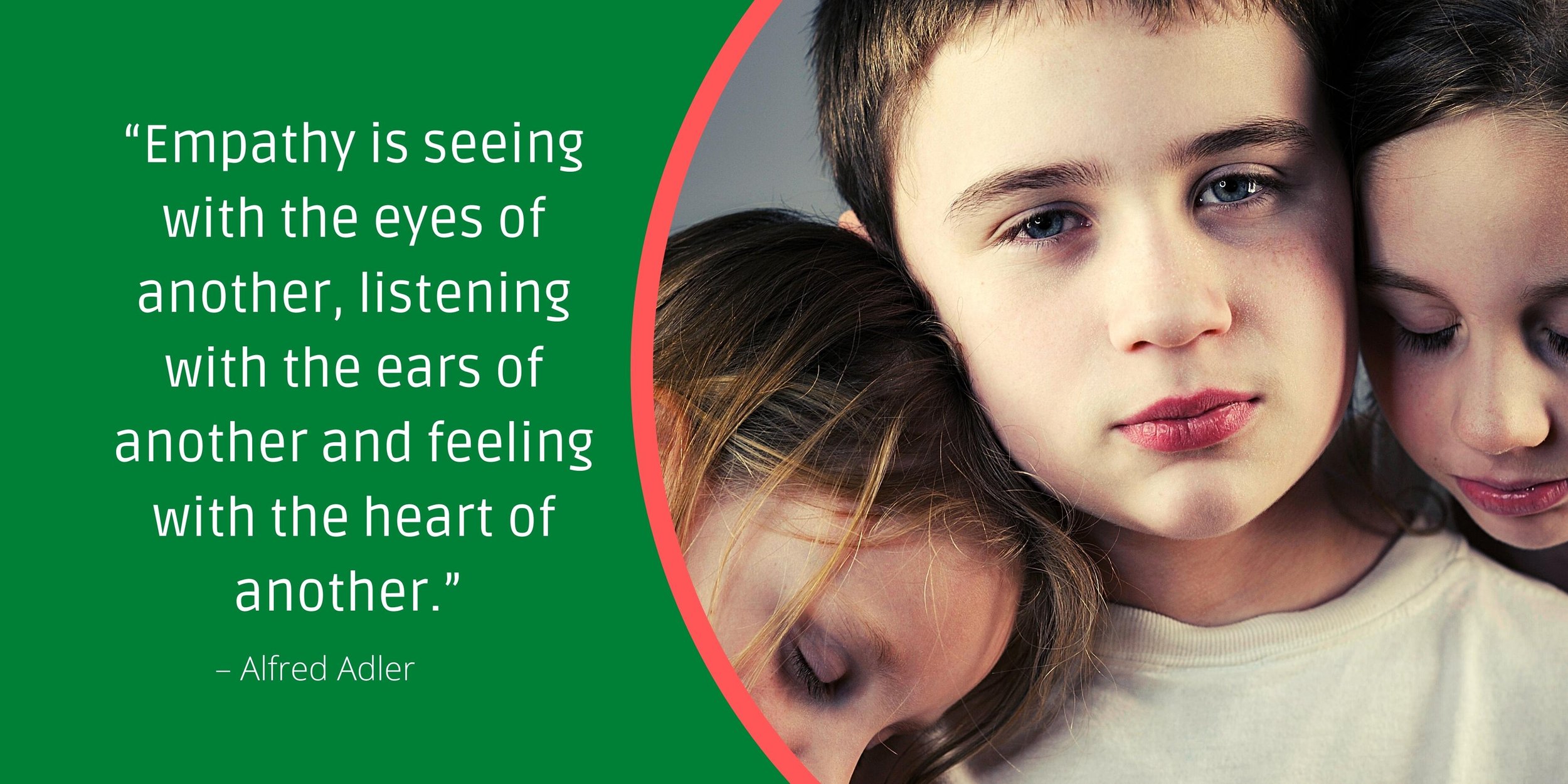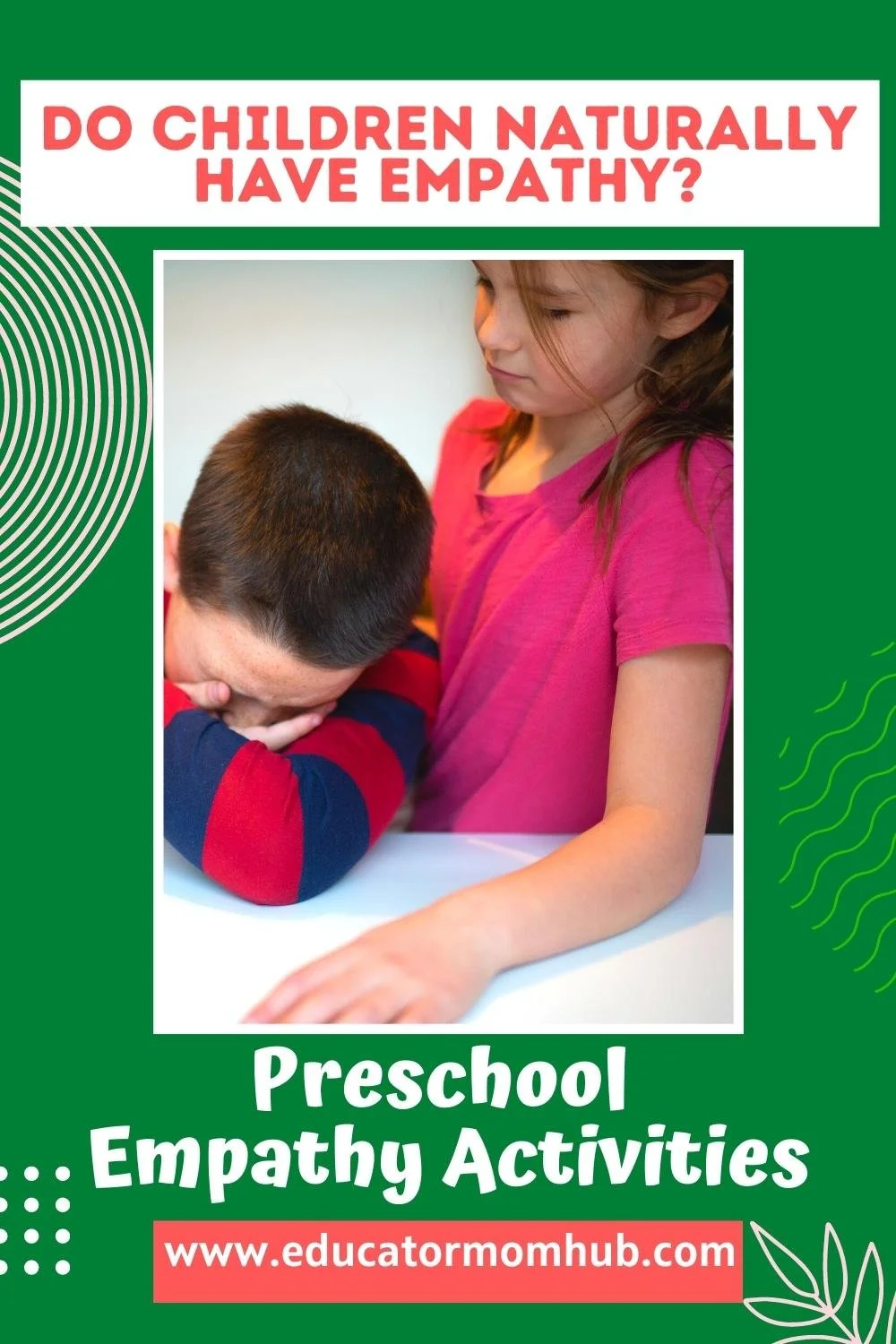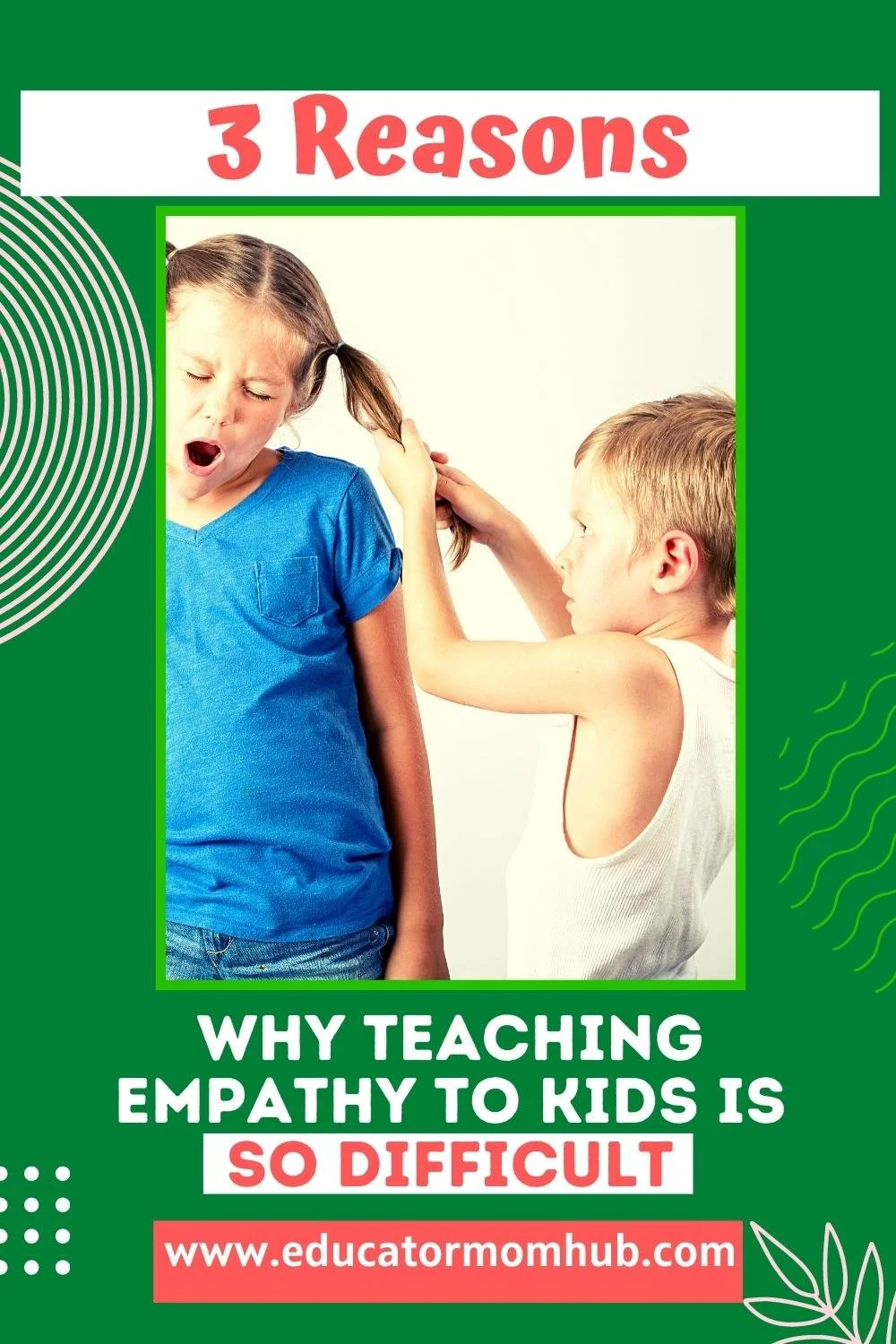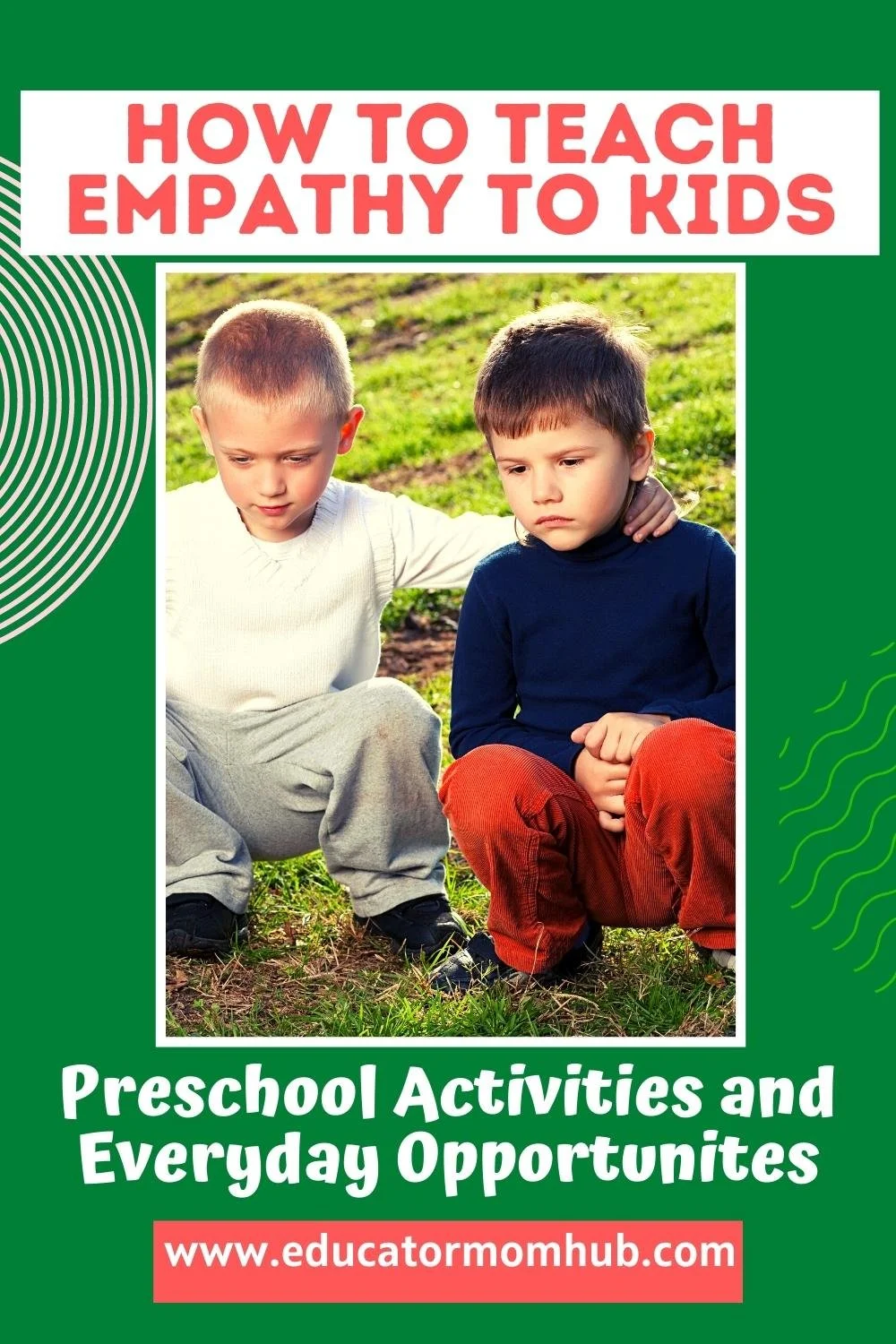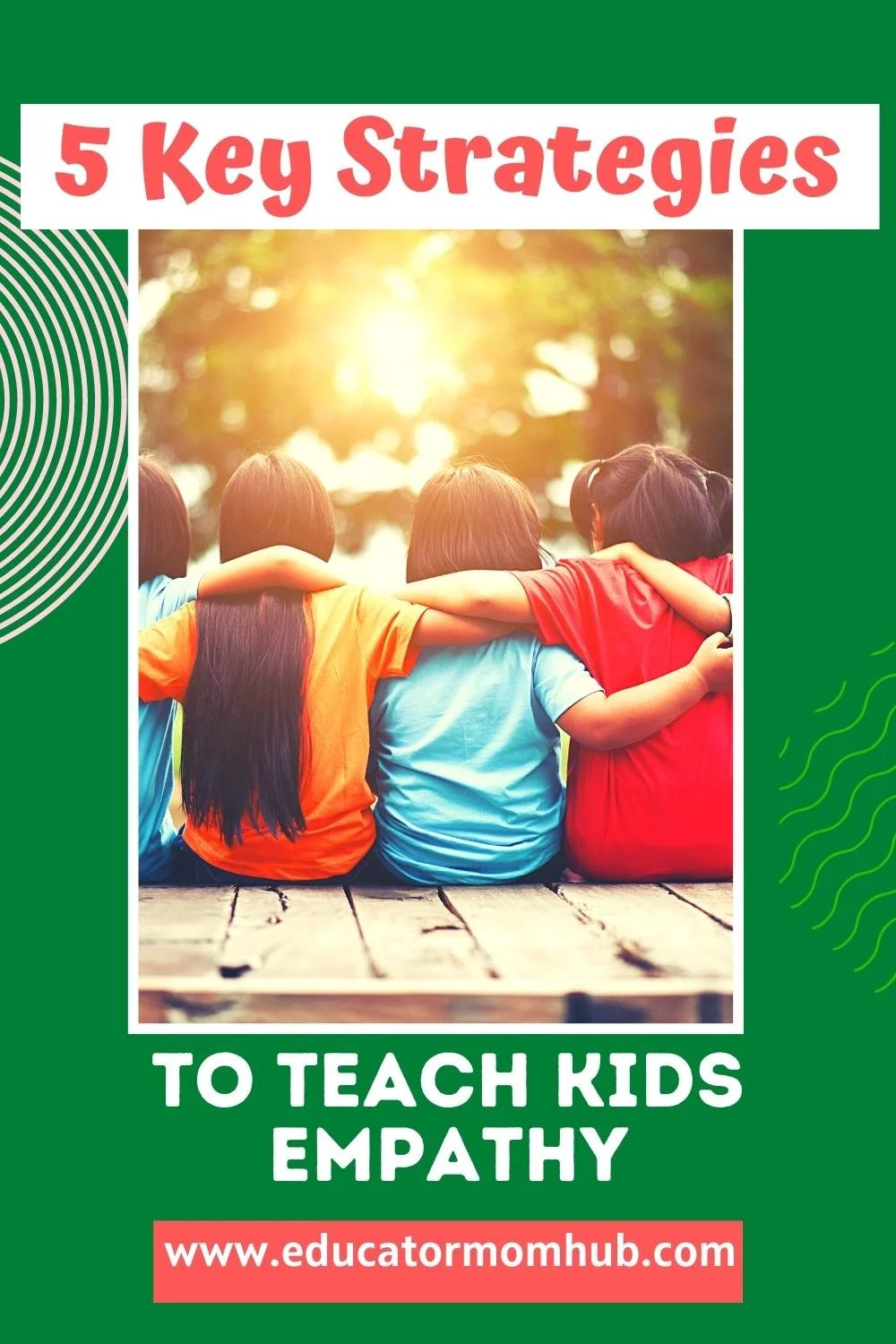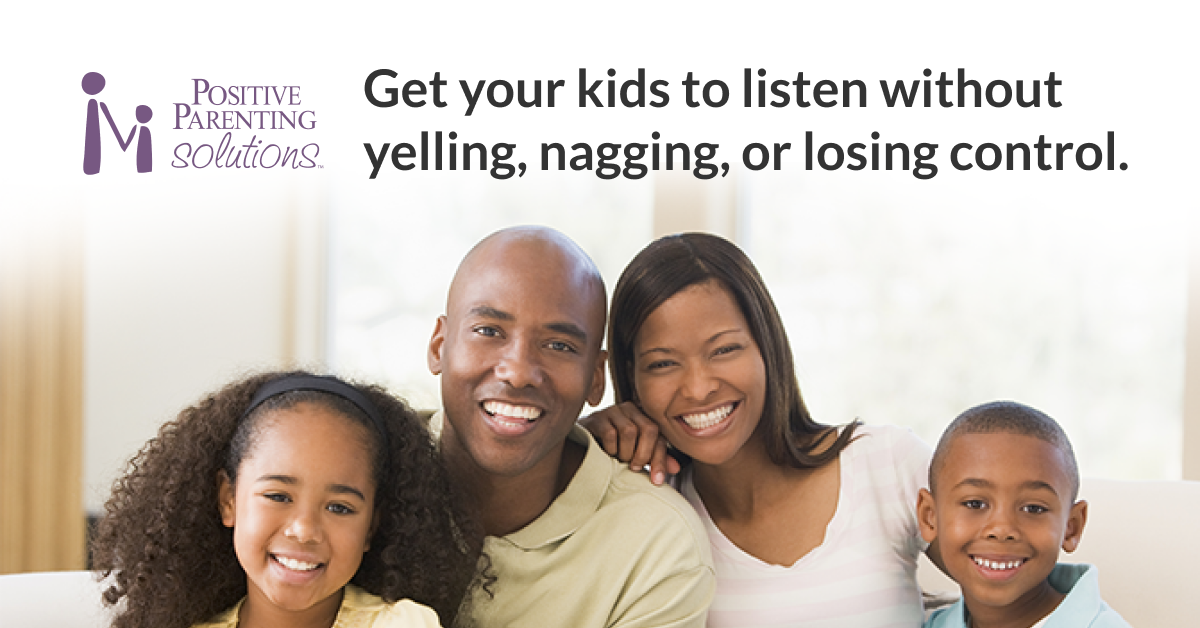How to Teach Empathy to Kids- With Everyday Opportunities and Pre-school Activities
Disclaimer: This page contains affiliate links. If you choose to make a purchase after clicking a link, I may receive a small commission at no additional cost to you. Thank You for your support.
If you're a mom of a young child, you know that teaching empathy is one of your most important jobs.
After all, empathy is the foundation for forming healthy relationships and creating a more compassionate world.
But where do you start?
And what can you do to help your preschooler develop empathy?
Read on for tips and fun hands-on preschool activities for teaching empathy to your little one.
What Is Empathy?
Empathy is the ability to understand and share the other person's feelings and emotions.
It's different from sympathy, which is feeling sorry for someone.
With empathy, we can see the world from another person's perspective and feel with them.
Why Is Empathy Important?
Empathy is essential for our kids' social and emotional development.
It helps us understand and relate to other people's feelings.
Empathy also leads to more positive relationships, as well as a decrease in bullying behavior.
Do Children Naturally Have Empathy?
Empathy is actually something that needs to be taught to children, as they do not naturally have it.
Infants as young as six months old show signs of concern when they hear other babies crying, but they do not yet understand what crying means.
It is only by around age two or three that children begin to develop a more sophisticated understanding of emotions and start to feel empathy for others.
This is why it is so important for parents to begin teaching their children about empathy early on.
Why Is Empathy Important in Child Development?
It helps children develop social skills.
Social-emotional skills help children understand and feel what others are feeling, they are better able to respond in a way that is helpful and supportive.
It helps children build strong relationships.
When children feel empathy for their friends, they are more likely to be kind and caring towards them, which lays the foundation for lasting friendships.
Empathy is important because it helps children understand and respond to the emotions of others.
When children can empathize with someone sad, for example, they are more likely to comfort them and try to make them feel better.
Why Is Teaching Empathy to Kids so Difficult?
One of the challenges in teaching empathy in early childhood is that young kids are egocentric.
This means that they tend to think only about their own needs and feelings and have difficulty understanding another person's perspective.
This egocentricity begins to decline around age seven or eight, but until then, it can be difficult for children to understand others feeling.
Another challenge in teaching empathy to younger children is that they are concrete thinkers.
This means that they have difficulty understanding abstract concepts like emotions.
For children, it can be difficult to understand why someone might be feeling sad or angry if they don't see those emotions on the person's face.
Lastly, another challenge in teaching kids empathy is that they often have a hard time regulating their own emotions.
This means that they might have trouble empathizing with someone who is feeling sad or angry if they are feeling those emotions themselves.
Developing empathy takes time and practice, and parents need to be patient with their children as they are learning.
How Can Parents Help Their Children Develop Empathy?
Help children develop a sense of morality that depends on internal self-control and not external rewards and punishments
One way to help your kids develop empathy is by teaching children about morality. Morality is a code of conduct that helps us tell right from wrong.
It's important to teach your kids that there are consequences for their actions, but that these consequences should come from within themselves and not from external rewards or punishments.
2.Make caring for others a priority and set high ethical expectations
Another way to foster empathy is to make caring for others a priority in your family.
This can be done by setting high ethical expectations and modeling compassionate behavior.
You can also talk about current events and discuss how people are feeling in different situations.
By showing empathy for others you will help your child become empathetic and understand the emotions of others.
Here is a helpful article on How To Be A Good Role Model To Kids-15 Characteristics
3.Empathize with your child
It's important to empathize with your child when they are experiencing strong emotions.
This will help them to understand that you understand how they are feeling.
It will also help them to feel more comfortable talking about their emotions.
When you empathize with your child, you are teaching them emotional empathy.
4.Help young children improve their face-reading skills
One way to help your child develop empathy is to teach them how to read facial expressions.
This can be done by pointing out different emotions on people's faces and talking about what they might be feeling.
You can also use books, puppets, or pictures to help your child identify different emotions.
When kids learn to read facial expressions, it helps them to understand the emotions of others.
Here is an article on How to Teach Kids About Feelings and Emotions
5.Don't keep your child from discussing race. Talk openly about racism and injustice
It's important to talk openly about racism and injustice with your child.
This will help them to understand the experiences of people who are different from them.
It will also help them to establish empathy for others.
By talking about these things, you will help your child become a more compassionate and caring person.
Encourage children to see things from other people's perspectives.
6.Help kids discover what they have in common with others
Help kids discover what they have in common with others.
This can be done by talking about your own experiences and sharing stories about people who are different from you.
You can also read books or watch movies that feature characters from different cultures.
Teaching children to discover what they have in common with other people's emotions, will help them to grow empathy and understanding.
7.Understand how guilt and shame affect children's empathic responses
Pin this Post to Pinterest
Guilt and shame can hurt children's ability to empathize with others.
Guilt is negative feelings about something you did, while shame is feeling bad about yourself.
If a child feels guilty or ashamed, they may be less likely to empathize with someone else who is going through the same thing.
It's important to help your child understand these emotions and how they can affect their ability to empathize with others.
5 Key Strategies to Teach Children Empathy
There are a few things that parents can do to help their kids develop emotional intelligence.
1. Model empathy yourself.
The best way is to demonstrate empathy yourself.
When you show compassion and concern for others, your child will learn that this is how they are supposed to behave as well.
Demonstrate how to respond to verbal and well as nonverbal cues.
For example, if you see someone who looks sad, you might say, “That person looks like they’re having a really tough day. I wonder what’s going on.”
Point out people’s feelings in books and movies.
When you’re reading a book or watching a movie with your child, take the opportunity to point out how different characters are feeling.
For example, you might say, “The little girl in this book is scared because she doesn’t know where her mom is.”
Encourage your child to put themselves in other people’s shoes.
You can do this by asking them questions such as, “How do you think she feels?” or “What would you do if that happened to you?”
This will help children understand how other people might feel in different situations and learn to empathize with them.
2. Talk Openly about Feelings
Another way to teach empathetic behavior is to talk openly about feelings with your child to develop emotional awareness.
When you name emotions and discuss how they make you feel, your child will begin to understand that everyone has feelings and that those feelings should be respected.
Try to label emotions for your child.
For example, “I see that you’re feeling frustrated. That can be tough to deal with.”
Or, “It looks like you’re feeling really happy right now! That makes me feel happy too.”
Not only will this help your child understand what empathy is, but it will also give them the words to express their own emotions.
3. Teach your child how to manage their own emotions.
If children can’t manage their own emotions, they won’t be able to understand or respond to the emotions of others.
Help them label their feelings and teach them how to cope in healthy ways.
For example, if your child is feeling angry, you might say, “It sounds like you’re really mad.
It’s OK to be mad, but it’s not OK to hit. What can we do instead?”
4. Encourage Perspective Taking
Perspective-taking is an important skill for children, as it is the foundation for empathy.
It is the ability to see things from another person’s point of view and understand other people's feelings.
Being able to take in different perspectives is an important part of developing cognitive empathy.
You can encourage perspective-taking by asking your child questions such as, “How do you think she feels?” or “What would you do if that happened to you?”
You can also encourage your child to put themselves in someone else’s shoes by reading stories together and talking about the characters’ feelings.
5. Encourage Pro-Social Behaviour
Pro-social behavior is any behavior that is intended to help another person.
Encouraging pro-social behavior will teach kids empathy for others.
There are several things you can do to encourage pro-social behavior in your child.
You can praise your child when they display pro-social behavior.
For example, “I’m so proud of you for sharing your toy with your brother.”
You can also provide opportunities for your child to help others.
For example, you can have them help you cook dinner or clean up the house.
Developing Empathy Using Everyday Opportunities - Examples
Using everyday opportunities as a teaching moment, parents can help their children develop a more emphatic view of the world.
By encouraging the simple act of noticing and caring, parents can help their children develop this important skill of emotional awareness into a lifelong habit.
Here are some examples of how children can practice empathy in everyday life.
* When you see a friend who looks sad, point it out to your child and ask if they want to go talk to the person.
* If your child sees a classmate trip and fall, encourage them to go over and help the child up.
* If your neighbor’s house is broken into, explain to your child how the family might be feeling and see if there is anything your child can do to help, such as making a card or bringing over a toy.
* If you see a homeless person on the street, explain to your child that the person is hungry and doesn’t have a place to live. See if there is anything your family can do to help, such as bringing food or clothes.
* When you see someone in a wheelchair, explain to your child that the person has a disability and might need help. See if there is anything your child can do to help without being intrusive, such as holding the door open or offering to carry something.
* If the younger sibling is crying, explain to your child that the baby is hungry or wet and needs help. See if there is anything your child can do to help, such as getting a diaper or a bottle.
* When you are at the grocery store, have your child help you pick out food to donate to the food bank.
* Ask your child’s teacher if there is a student in the class who could use a friend. Encourage your child to sit with that student at lunch or include them in games at recess.
*When a sibling is crying, see if they can help. If they can't, encourage them to try and make the sibling feel better in other ways.
These are just a few examples of how you can encourage empathy daily.
It is important to remember that children learn best by example. So, be sure to model empathy yourself!
This article shares a Christmas Avent Calendar that encourages children to do a kind deed each day leading up to Christmas. However, you can also use this outside of Christmas as a wonderful resource to teach your child empathy and kindness.
Hands-On Preschool Activities for Teaching Empathy
In addition to using everyday opportunities, there are also some specific activities that parents can use for teaching empathy to their preschoolers.
Puppet show
Have your child put on a puppet show with puppets that display different emotions.
As they are play-acting, talk about the feelings that the puppets are experiencing.
You can also recreate a past event. eg a previous disagreement in the sandpit to help your child understand how other children must have felt.
Role Playing
Pretend play is another great way to help children understand the perspective of others.
You can set up different scenarios and have your child act out how they would respond.
For example, you can say, “Your best friend comes to school crying because their pet died. How would you comfort your friend?”
Drawing
Drawing is a great way for children to express their feelings.
Ask your child to draw a picture of themselves and then have them label the different emotions they are feeling.
You can also ask them to draw a picture of a character from their favorite book and how it was feeling in a particular scene.
This is also a great opportunity for some emotion coaching; recognising and labeling the emotion and exploring the problem and solutions.
Note: This activity is not focused on producing well-structured drawings but rather on the child's emotional comprehension.
Feelings and Emotions Flashcards
Play a game with these emotions and feelings cards, where you name different emotions and have your child act them out.
You can also use pictures on flashcards to help your child identify the emotions, and match emotions, and body language.
Books
Read books that deal with empathy, such as ' a little spot of emotions box set'.
The colorful illustrations and the engaging stories encourage social and emotional learning in kids.
Feelings chart
Help your child identify and label their emotions by using this Feelings chart.
You can use pictures, words, or both.
Happy or Not
Culturally diverse, accurately illustrated expressions on cards that help children learn to read faces.
Use these cards to initiate conversations and make predictions about the characters, their emotions, and the events in the story.
Feelings jar
This is a fun activity that can help kids identify and express their feelings. Every day, have your child draw a feeling out of the jar and act it out.
Storytelling
Encourage your child to make up their own stories or retell a favorite book.
As they are telling the story, talk about how the different characters are feeling and how they could help.
Watch our read -aloud Storytime in author’s voice.
Make a card for someone having a difficult day.
Have your child express verbally why they are making this card and what change they are expecting to make.
By doing these activities regularly, you can guide children to understand the emotions of others.
Conclusion
Teaching empathy to your child is one of the most important things you can do to help them succeed in life.
It's important to start early, be a good role model, and use activities that encourage social and emotional learning.
By doing these things, you will help your child develop empathy and understand the emotions of others.
In turn, this will help them to be more successful in social situations and have healthier relationships.
What are some other ways that you teach empathy to your child? We’d love to hear from you in the comments
FAQ
How do you teach empathy to a child?
There are many ways that you can teach empathy to your child. Some ways include being a good role model, using puppets to show emotions, role-playing different scenarios, and reading books that deal with empathy. You can also use a feelings chart or jar to help your child identify and label their emotions. For more ideas, see the blog post above.
Why is it important to teach empathy to children?
Teaching empathy to your child is one of the most important things you can do to help them succeed in life. It's important to start early, be a good role model, and use activities that encourage social and emotional learning. By doing these things, you will help your child develop empathy and understand the emotions of others. In turn, this will help them to be more successful in social situations and have healthier relationships.

